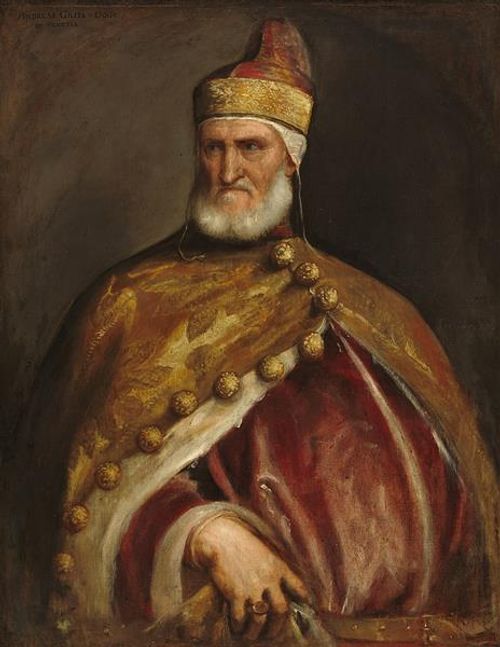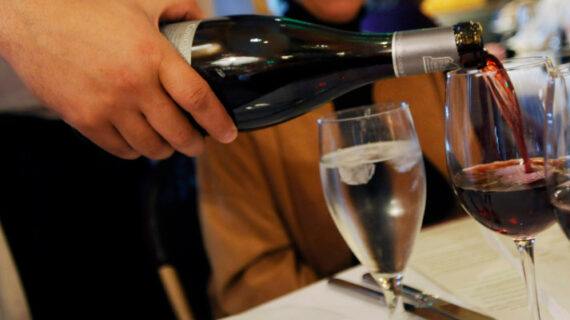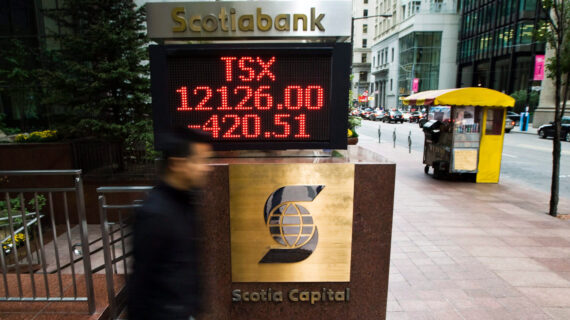Of Venice’s grand hotels, the Palazzo Gritti is the most modest and, for that reason, my favourite. There is none of the Instagrammable-opulence of the Danieli or the cool chic of the renovated St Regis. The Gritti is intimate, even cozy—or as cozy as a palazzo on the Grand Canal can be. Reading on one of the sofas off the lobby on a weekday afternoon under the imperious portrait of the eponymous Doge, you could imagine you are staying at the well-appointed private house of a friend of a friend. That is the feel of a proper hotel.
The painting of Andrea Gritti is a copy of the original by Titian, which hangs in the National Gallery of Art in Washington, DC. (And not to be confused with his portrait by Catena, which hangs in another National Gallery, in London.) Encountering it the first time I stayed here felt like bumping unexpectedly into an old friend. Despite the subject’s name, which knew from when I lived in Washington and haunted the National Gallery, I hadn’t made the obvious connection between the painting and the palace. Out of context, out of mind, or something.

On this visit, I was determined to learn more about the Doge. I started by visiting his funeral monument (possibly sculpted by Palladio) at San Francesco della Vigna, an out-of-the-way church I had missed on previous visits. I also spent time online tracing the original painting’s journey from Venice to America. This included stops in Charles I’s Palace at Whitehall, where it would have been admired by Van Dyck, and in Vienna, where it was one of more than 2,000 works of art purchased by the legendary collector Johann Rudolf, Count Czernin von Chudenitz (most of his collection can now be seen in Salzburg’s Residenzgalerie).
From Vienna, the painting followed what was by then a well-travelled transatlantic route to the collection of a rich American, Samuel Kress. Sam Kress had made his fortune with a national chain of five and dime stores he started in Eastern Pennsylvania. As the new century dawned, he found himself with newfound generational wealth but without its trappings. Like so many Americans of the Gilded Age, he rectified this by spending lavishly on European art. During his life, a gallery’s worth of Old Masters decorated his residences; when he died in 1955, he bequeathed them to more than twenty American museums.
The portrait of Doge Gritti, which Kress acquired only a year before he died, ended up at the new National Gallery in Washington, along with more than half his collection. The National Gallery itself had been a gift to the American people from the banker and industrialist Andrew Mellon in 1937. Mellon paid for the construction of the imposing neoclassical building on the Mall, and the initial collection was seeded from the private collections of Andrew and his son Paul, businessman Joseph Widener and Lessing Rosenwald, the banker Chester Dale, and Sam Kress. In addition to the Doge, the National Gallery has 14 more paintings attributed to Titian, his workshop, or his followers, and 12 by his Venetian contemporary, Giovanni Bellini (including one jointly attributed to the two painters. Almost all were gifts of Kress or Widener.
The National Gallery was a late example of American philanthropy. The Metropolitan Museum of Art had opened in New York more than half a century earlier, endowed with funds and works from the collections of John Taylor Johnston, a railway millionaire, Theodore Roosevelt, Sr, father of the future president, and Howard Potter, a partner in Brown Bros. & Co. Later donations came from Robert Lehman, of Lehman Brothers, J.P. Morgan, and several generations of Rockefellers, who donated the land and built an architecturally-inspired home for the museum’s medieval collection at the Cloisters.
Collecting was something of a mania for the early American rich, and so was philanthropy. Frick, Morgan, Gardner, Getty, Carnegie, Guggenheim: their names, once headlines in the financial press, are now remembered more for the museums, libraries, and universities they left behind. The art historian Bernard Berenson, who spent much of his life identifying acquisitions for them from his villa in Tuscany, called them his “squillionaires.” Through the London-based art dealer, Joseph Duveen, “BB” negotiated the transfer of thousands of works of art from Europe’s mouldering churches and crumbling castles to the bright palaces of America’s new elite.
This habit of bulk collecting, treating Europe as a sort of Gilded Age Costco, was parodied by Orson Welles in Citizen Kane. In the first flush of fortune, a young Charles Foster Kane and his bride arrive home from their European honeymoon to a gloomy California-kitsch palace with crates of art in tow. Later, in the movie’s last scene,1Citizen Kane – Rosebud Scene Kane’s executors stand in an enormous warehouse, puzzling over his dying words. As they wonder, they are dwarfed, literally overshadowed, by a disordered jumble of objets d’art piled high like a city skyline above them, the abandoned profits of an acquisitive life.
It was easy to mock the American industrialists’ affinity for old world style—new money is always faintly ridiculous—but their general (if sometimes indiscriminate) good taste and generosity left America with an artistic endowment worthy of its rising status. It is a glorious legacy, which seems all the more remarkable next to the cultural vacuum inhabited by the current generation of tycoons. I don’t expect much in the way of good taste from Mark Zuckerberg, who honeymooned in Rome and ate at McDonald’s,2Mark Zuckerberg Forgets To Tip, Eats McDonald’s While On Roman Honeymoon but what about the rest of our tech oligarchs?
Where are Silicon Valley’s great public buildings and monuments? Where are the libraries? Where are the museums? Or, to compare them to earlier elites, where are the paintings, sculptures, operas, and poetry they have commissioned? Where, in short, are the patrons?
Where is Mark Zuckerberg’s David (Donatello’s bronze was commissioned by Cosimo de Medici)? Jeff Bezos’s Bernini sculptures (commissioned by Scipione Borghese and still housed in his former villa)? Elon Musk’s Haydn Masses (commissioned by Prince Nikolaus Esterhazy—surely we could use a new “Mass in Troubled Times”)? Steve Ballmer’s Shakespeare sonnets (William Herbert, 3rd Earl of Pembroke was one of Shakespeare’s patrons, and the most likely candidate to be the “Mr W.H.” to whom the sonnets were dedicated)? Sergey Brin’s Whistler paintings (commissioned by Charles Freer and Frederick Leyland)?
Where are the modern equivalent of the chapels and funeral monuments that put Michelangelo, Bernini, and Canova to work immortalizing their patrons? Where is Larry Page’s Taj Mahal?
Where, for that matter, are the stately, taste-making and era-defining public homes of today’s billionaires? Merely saying the words Blenheim, Versailles, Villa Medici, or Biltmore House conjures the profiles of those grand homes, all of which are now open to the public and enjoyed by millions of visitors each year. But can you even picture one of Bill Gates’s or Mark Zuckerberg’s houses? Today’s rich do not build either the sort of urban mansions that still line the fashionable streets of Rome, London, Manhattan, and Montreal, or the country estates where their predecessors fêted the world’s diplomats, artists, and thinkers. They do not aspire to be civic leaders, so they live hidden away in guilty privacy.
We visit places like Venice, Florence, and Vienna to live, however temporarily, in the midst of a beauty built by wealth. The Emperor Augustus is supposed to have reflected at the end of his life that he found Rome a city of brick and left it a city of marble. On a lesser scale this is also what the great families of Europe and America did for the next two thousand years. They built and rebuilt the monuments and palaces, the monasteries and universities, the chapels and chantries, and the civic buildings that we now flock to see and gawk at. And yet it does not seem to occur to their successors to keep the project going and ornament their own cities. The modern rich have the money—goodness knows they have the money3The world’s richest person, Elon Musk, has a net worth of $226.8B USD—but they lack the nobility of spirit that seeks commemoration in enduring beauty.
Sometime in the last century, the rich stopped thinking like the rich of every generation before them stretching back to Maecenas4“Gaius Cilnius Maecenas (c. 70 – 8 BC) was a friend and political advisor to Octavian, who later reigned as Augustus. He was also an important patron for the new generation of Augustan poets, including both Horace and Virgil. During the reign of Augustus, Maecenas served as a quasi-culture minister to the Roman emperor but in spite of his wealth and power he chose not to enter the Senate, remaining of equestrian rank.” https://en.wikipedia.org/wiki/Gaius_Maecenas and the choragoi of Ancient Greece.5“In the theatre of ancient Greece, the chorêgos (pl. chorêgoi; Greek: χορηγός, Greek etymology: χορός ‘chorus’ + ἡγεῖσθαι ‘to lead’) was a wealthy Athenian citizen who assumed the public duty, or choregiai, of financing the preparation for the chorus and other aspects of dramatic production that were not paid for by the government of the polis or city-state.” https://en.wikipedia.org/wiki/Choregos They stopped feeling responsible for the cultural life of their fellow citizens and their cities. This abdication of cultural responsibility is something new, but it is consistent with the new economy in which our new rich have made their fortunes. They have profited from a global economy and, in return, they pour billions of dollars into foreign humanitarian projects while ignoring their nominal hometowns. It is another sign of the disconnection of wealth from place.
Global commerce is indifferent to flesh-and-blood community. Whereas Andrea Gritti courted artistic talent from around the world to add to the glory of Venice—it was Gritti who commissioned the Florentine Jacopo Sansovino to bring order to a previously scruffy Piazza San Marco—the new “global” rich care more about doing good for strangers overseas than for their neighbours at home. And, with rare exceptions, they appear to care nothing at all for art and architecture, let alone music, theatre, and religion. The cultural treason of our spiritless billionaires is only mitigated by imagining the ghastly stuff they would probably collect and commission if they bothered to.




